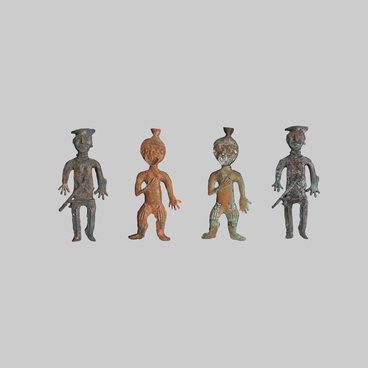The Scythian stone statue is a flat schematic representation of a human figure. The head looks like a rounded projection separated from the body by a shallow groove. The face is flat, round, and blank. The chin is level with the rounded shoulders. The waist is outlined by deep grooves, the sides and hips are curved. The lower part of the statue has probably broken off. The statue is made of coarse greyish-brown polymictic sandstone with a layered texture.
According to archaeologist Sergei Botalov, the statue depicts a female, as evidenced by the curved hips and torso. The statue has clearly been influenced by the Scythian visual art traditions (5th–4th centuries BC).
It was discovered by a scouting party led by Sergei Botalov during archaeological exploration of the route of the projected Ob-Aral Sea channel in 1985. The statue was found during the study of the Naurzum burial ground on the southern border between the Chelyabinsk and Kostanay regions. It was discovered in the grave pit, but initially stood at the top of the mound. Later, when the catacomb vaults gave way or the burial ground was plundered, the statue ended up in an sinkhole.
The Naurzum statue looks like a stele or a pillar with a well-defined head emphasized by the image of a torc. The neck is absent, the shoulders are straight or sloping and raised to mouth level, and the chin is lowered to the chest. Such statues appeared in the 6th century BC and were used until the 5th–4th century BC. The shape of the head and shoulders, the relative position of the shoulders and chin, and the use of small depressions to depict the eyes makes the Naurzum statues similar to the statue from the Bolshaya Glushnitsa burial mound. But they have even more in common in terms of head and body shape with a group of anthropomorphic statues from the Lower Dnieper region. Scythian anthropomorphic sculptures of this type were used in special places of worship and were an integral part of sacrificial sanctuaries. The sculptures often depicted warriors with weapons. They were made of monolithic blocks or slabs, which were cut and shaped to resemble a human figure.
According to archaeologist Sergei Botalov, the statue depicts a female, as evidenced by the curved hips and torso. The statue has clearly been influenced by the Scythian visual art traditions (5th–4th centuries BC).
It was discovered by a scouting party led by Sergei Botalov during archaeological exploration of the route of the projected Ob-Aral Sea channel in 1985. The statue was found during the study of the Naurzum burial ground on the southern border between the Chelyabinsk and Kostanay regions. It was discovered in the grave pit, but initially stood at the top of the mound. Later, when the catacomb vaults gave way or the burial ground was plundered, the statue ended up in an sinkhole.
The Naurzum statue looks like a stele or a pillar with a well-defined head emphasized by the image of a torc. The neck is absent, the shoulders are straight or sloping and raised to mouth level, and the chin is lowered to the chest. Such statues appeared in the 6th century BC and were used until the 5th–4th century BC. The shape of the head and shoulders, the relative position of the shoulders and chin, and the use of small depressions to depict the eyes makes the Naurzum statues similar to the statue from the Bolshaya Glushnitsa burial mound. But they have even more in common in terms of head and body shape with a group of anthropomorphic statues from the Lower Dnieper region. Scythian anthropomorphic sculptures of this type were used in special places of worship and were an integral part of sacrificial sanctuaries. The sculptures often depicted warriors with weapons. They were made of monolithic blocks or slabs, which were cut and shaped to resemble a human figure.



